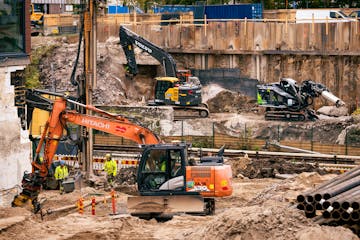Low-carbon construction sites
Emissions from construction sites affect us all. Construction is one of the largest sources of carbon dioxide emissions in Finland. By reducing emissions generated during construction, we can directly influence Finland’s total emissions and lessen the burden on our living environment. All SRV construction sites have been low-carbon since the beginning of 2022.
The main sources of emissions on construction sites are electricity, heating and fuel used in machinery. Since early 2022, we have made our construction sites lifecycle-wise through the following measures:
Using renewable or zero-emission electricity and heating
Around one third of the carbon dioxide emissions on our sites come from electricity consumption, one third from district heating and one third from fuel use. At the beginning of 2022, we switched to purchasing carbon-neutral energy, meaning renewable or zero-emission electricity and heat. In addition, on sites where the completed building will use geothermal energy, the geothermal system is implemented as early as possible so that the site can benefit from geothermal heat during construction.
Biofuels and electricity for machinery
The machinery working on our sites uses biofuels whenever possible. Change does not happen overnight, but our direction is clear. We are steadily increasing the use of biofuels and encouraging our partners to move towards machinery powered by biofuels. We are also testing electrically powered machinery. We believe that electric equipment will continue to develop and offer more options for emission-free construction sites in the future.
Replacing fossil fuels with biofuels and electricity also enables better air quality on our sites and in their surrounding areas.
Concrete climate actions
We cannot eliminate all emissions, and at company level we have therefore decided to carry out concrete climate actions. For example, together with our partner we plant 16,700 trees each year, which will absorb 10,000 tonnes of carbon dioxide over their lifetime. Our aim is to reduce emissions gradually and achieve net zero for our own operations by 2030.
